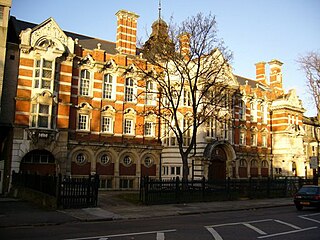Related Research Articles

Camberwell College of Arts is a constituent college of the University of the Arts London, a public art and design university in London, England. The college offers further and higher education programmes, including postgraduate and PhD awards. The college has retained single degree options within Fine Art, offering specialist Bachelor of Arts courses in painting, sculpture, photography and drawing. It also runs graduate and postgraduate courses in fine art as well as design courses such as graphic design, illustration and 3D design. It has been ranked as the top British art school by The Times.

Marimekko Corporation is a Finnish textiles, clothing, and home furnishings company founded by Viljo and Armi Ratia in Helsinki in 1951. Marimekko made important contributions to fashion in the 1960s. It is particularly noted for its brightly colored printed fabrics and simple styles, used both in women's garments and in home furnishings.

Dame Zandra Lindsey Rhodes,, is an English fashion and textile designer. Her early education in fashion set the foundation for a career in the industry creating textile prints. Rhodes has designed garments for Diana, Princess of Wales and numerous celebrities such as rock stars Freddie Mercury and Marc Bolan. She has also designed textiles for interiors, featuring her prints on furniture and homewares. In 2003 Rhodes founded the Fashion and Textile Museum in London.

Liberty, commonly known as Liberty's, is a luxury department store in London, England. It is located on Great Marlborough Street in the West End of London. The building spans from Carnaby Street on the East to Kingly Street on the West, where it forms a three storey archway over the Northern entrance to the Kingly Street mall that houses the Liberty Clock in its centre. Liberty is known around the world for its close connection to art and culture, but it is most famous for its bold and floral print fabrics. The vast mock-Tudor store also sells men's, women's and children's fashion, beauty and homewares from a mix of high-end and emerging brands and labels.

Textile design, also known as textile geometry, is the creative and technical process by which thread or yarn fibers are interlaced to form a piece of cloth or fabric, which is subsequently printed upon or otherwise adorned. Textile design is further broken down into three major disciplines: printed textile design, woven textile design, and mixed media textile design. Each uses different methods to produce a fabric for variable uses and markets. Textile design as an industry is involved in other disciplines such as fashion, interior design, and fine arts.

Helen David is an English fashion designer and artist based in London, England.

Fashion design is the art of applying design, aesthetics, clothing construction and natural beauty to clothing and its accessories. It is influenced by culture and different trends and has varied over time and place. "A fashion designer creates clothing, including dresses, suits, pants, and skirts, and accessories like shoes and handbags, for consumers. He or she can specialize in clothing, accessory, or jewelry design, or may work in more than one of these areas."

Désirée Lucienne Lisbeth Dulcie Day OBE RDI FCSD was one of the most influential British textile designers of the 1950s and 1960s. Day drew on inspiration from other arts to develop a new style of abstract pattern-making in post-war British textiles, known as ‘Contemporary’ design. She was also active in other fields, such as wallpapers, ceramics and carpets.

Sabyasachi Mukherjee is an Indian fashion designer, jewelry designer, retailer and couturier from Kolkata, India. Since 1999, he has sold designer merchandise using the label Sabyasachi. Mukherjee is one of the Associate Designer Members of Fashion Design Council of India and the youngest board member of the National Museum of Indian Cinema. He has designed costumes for Bollywood films such as Guzaarish, Baabul, Laaga Chunari Mein Daag, Raavan, and English Vinglish.

Enid Crystal Dorothy Marx, RDI, was an English painter and designer, best known for her industrial textile designs for the London Transport Board and the Utility furniture Scheme. Marx was the first female engraver to be designated as a Royal Designer for Industry.

Jack Lenor Larsen was an American textile designer, author, collector and promoter of traditional and contemporary craftsmanship. He was noted for bringing fabric patterns and textiles to go with modernist architecture and furnishings. Some of his works are part of permanent collections at museums, including the Museum of Modern Art, the Victoria and Albert Museum, the Art Institute of Chicago, the Musée des Arts Décoratifs at the Louvre, and the Minneapolis Institute of Art, which has his most significant archive.

Linda Jackson is an Australian fashion designer, fashion retailer and artist.

Zika Ascher, born Zikmund Ascher and nicknamed "The Mad Silkman", was a Czech textile businessman, artist and designer who became pre-eminent in the related fields of British textiles, art, and fashion. He created his own textile company, which made its name with experimental fabrics and scarves designed by famous contemporary artists.

Devoré is a fabric technique particularly used on velvets, where a mixed-fibre material undergoes a chemical process to dissolve the cellulose fibres to create a semi-transparent pattern against more solidly woven fabric. The same technique can also be applied to textiles other than velvet, such as lace or the fabrics in burnout t-shirts.
Crolla was a 1980s British high fashion brand and boutique founded by Scott Crolla and Georgina Godley in Mayfair's Dover Street. Always niche, it was influential for its juxtaposition of unusual and vintage fabrics and traditional tailoring. Describing the brand's signature at the time, Scott Crolla said: "My clothes are for someone who disregards fashion but enjoys fabrics… I would call it a calculated disregard for conventional taste." In the book London: After Fashion, Alistair O’Neill described the look as: “as odd a combination as Coward in Las Vegas, but it communicated a vision of Englishness just as brashly."

Neisha Crosland is a British-born, London-based textile designer, who works in the fields of furnishing fabric, wallpaper and interiors products. Her designs have featured in the ranges of British brands such as Osborne & Little and John Lewis. Internationally, her work is also recognised and she has a collection for Hankyu department stores in Japan.

Marion Victoria Dorn also known as Marion Dorn Kauffer was a textile designer primarily in the form of wall hangings, carpeting and rugs, however she is also known to have produced wallpaper, graphics, and illustrations. Known for her significant contributions to modern British interiors in particular for her 'sculpted' carpets, she contributed to some of the best-known interiors of the time including the Savoy Hotel, Claridges, the Orion and the Queen Mary. In the late 1930s and early 1940s she created moquette fabric designs for use in London Transport passenger vehicles.
Susan Jane Collier was an English textile designer. She began in a freelance capacity and sold sketches to scarf brands Richard Allan and Jacquar. Collier joined Liberty in 1961, and specialised in floral prints dresses. She was helped by her sister Sarah Campbell starting in 1968, and co-founded the independent Collier Campbell Ltd studio in 1979.

Shrimps is a fashion label founded by London-based designer, Hannah Weiland, launched in 2013. Originally launched with one faux fur coat and then centred around faux fur outerwear and accessories, Shrimps is now a full RTW label offering a variety of pieces as well as the faux fur outerwear that made its name. Shrimps became famous for its signature faux fur coats, garnering support from animal rights activists such as PETA, and drawing new attention to faux fur as a fabric in fashion.
Sonnhild Kestler is a Swiss textile designer. She was awarded the Schweizer Grand Prix Design in 2010 for her life's work. Her work was exhibited at the Museum of Design, Zurich in 2011. With the block printing method Kestler creates intricate textiles in limited series.
References
- ↑ John Crace, The Sum of its Arts, Theguardian.com, 27 April 2004
- ↑ Teresa Waite, Style Makers; Georgina von Etzdorf, Fashion and Textile Designer, Nytimes.com, 2 February 2002
- ↑ Sally Williams, Designers – complete with accessories, Independent.co.uk, 21 June 1996
- ↑ The Times: It’s a rug revolution [ dead link ]
- ↑ "RSA - Current Royal Designers". Archived from the original on 2012-08-27. Retrieved 2012-09-09. Royal Designers for Industry
- ↑ "Honorary Fellows and Doctorates". Archived from the original on 2006-05-05. Retrieved 2014-08-24. University of the Arts
- ↑ Manchester Art Gallery - Georgina von Etzdorf: 25 years of sensuous textiles
- ↑ Angus Montgomery, Inside Eden, Designweek.co.uk, 24 February 2011
